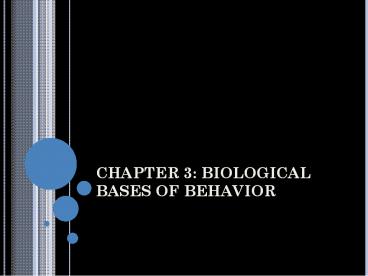CHAPTER 3: BIOLOGICAL BASES OF BEHAVIOR - PowerPoint PPT Presentation
Title:
CHAPTER 3: BIOLOGICAL BASES OF BEHAVIOR
Description:
CHAPTER 3: BIOLOGICAL BASES OF BEHAVIOR COMMUNICATION IN THE NERVOUS SYSTEM NERVOUS TISSUE: THE BASIC HARDWARE 2 major categories of cell in the nervous system: 1 ... – PowerPoint PPT presentation
Number of Views:104
Avg rating:3.0/5.0
Title: CHAPTER 3: BIOLOGICAL BASES OF BEHAVIOR
1
CHAPTER 3 BIOLOGICAL BASES OF BEHAVIOR
2
COMMUNICATION IN THE NERVOUS SYSTEM
3
NERVOUS TISSUE THE BASIC HARDWARE
- 2 major categories of cell in the nervous system
- 1 Glia---glue provide structural support and
insulation for neurons - 2 Neuron---individual cell in the nervous system
that receive, integrate, and transmit information
4
NEURON STRUCTURE
- Soma cell body contains nucleus
- Dendrite receive info.
- Axon long, thin fiber transmits signals from
soma to other neurons or muscles/glands - Myelin sheath insulating material (glia) around
axon - Terminal button secrete neurotransmitters
- Synapse space btwn neurons info transmitted
5
NEURAL IMPULSE AT REST
- Complex electrochemical reaction
- charged Na and K ions and neg. charged chloride
ions flow across membrane - Higher concentration of neg ions inside cell
creates voltage - Resting potential a neurons stable, negative
charge when the cell is inactive (c. -70
millivolts)
6
NEURAL IMPULSE ACTION POTENTIAL
- When neuron is stimulated
- Ion channels open charged Na ions rush in
- Charge is less neg. or even pos.
- This creates an Action potential brief shift in
a neurons electrical charge that travels along
an axon
7
NEURAL IMPULSE REFRACTORY
- Na channels close
- Absolute refractory period min. length of time
after an action potential during which another AP
cannot begin (1 or 2 milliseconds)
8
ALL-OR-NONE LAW
- Neuron either fires or doesnt
- Action potentials are all the same size
- Rate of action potentials tells strength of
stimuli - Size of axon effects rate
9
SYNAPSES
- Neurons do not touch
- Synaptic cleft microscopic gap btwn terminal
button of one neuron and the cell membrane of
another - Msgs. in the form of neurotransmitters chemical
info. from one neuron to another
10
NEUROTRANSMITTERS
- Most stored in synaptic vesicles in the terminal
buttons - They diffuse into the synaptic cleft
- Picked up by receptor sites of receiving neuron
11
POSTSYNAPTIC POTENTIALS (PSP)
- Def a voltage change at a receptor site on a
postsynaptic cell membrane - Vary in size
- Increase or decrease probability of an impulse
12
TYPES OF MESSAGES
- Excitatory PSP a positive voltage shift
increases likelihood that a postsynaptic neuron
will fire action potentials - Inhibitory PSP neg. voltage shift decreases
likelihood that a postsynaptic neuron will fire
action potentials
13
REUPTAKE
- Def a process in which neurotransmitters are
sponged up from the synaptic cleft by the
presynaptic neuron - Recycles material
- Some NTs are inactivated by enzymes or removed
(drift away)
14
NEUROTRANSMITTERS AND BEHAVIOR
- Over 100 possible NTs have been identified
- Specific NTs only work in specific receptors
- This is called the lock-and-key principle
- Meant to prevent mixing of NTs
15
ACETYLCHOLINE (ACh)
- Only transmitter btwn motor neurons and voluntary
muscles - Also contributes to attention, arousal, and
possibly memory
16
AGONIST AND ANTAGONIST
- Agonist chemical that mimics the action of a
neurotransmitter - Antagonist chemical that opposes the action of a
neurotransmitter---they block receptors
17
MONOAMINES
- Include dopamine, norepinephrine, and serotonin
- Dopamine voluntary movement, pleasurable
emotions - Serotonin sleep and wakefulness aggression and
impulsivity - Norepinephrine modulation of mood, arousal
18
ABNORMALITIES WITH MONOAMINES
- Low levels of norepinephrine and serotonin
synapses tied to depression - Abnormal dopamine activity tied to schizophrenia
19
ENDORPHINS
- Def the family of internally produced chemicals
that resemble opiates in structure and effect - Discovered by study of morphine effects
- Regulate pain, pleasure































